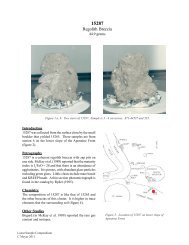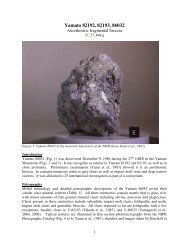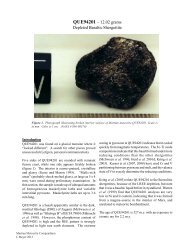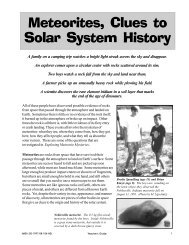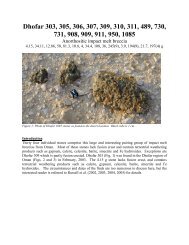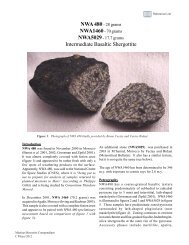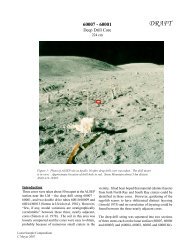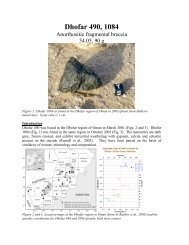M7 Meteorite Hills 01210 - NASA
M7 Meteorite Hills 01210 - NASA
M7 Meteorite Hills 01210 - NASA
Create successful ePaper yourself
Turn your PDF publications into a flip-book with our unique Google optimized e-Paper software.
<strong>Meteorite</strong> <strong>Hills</strong> <strong>01210</strong>Anorthosite-bearing basaltic fragmental breccia22.8 gFigure 1: <strong>Meteorite</strong> <strong>Hills</strong> (MET) <strong>01210</strong> as found in the bare ice in 2002.Introduction<strong>Meteorite</strong> <strong>Hills</strong> (MET) <strong>01210</strong> was found in the <strong>Meteorite</strong> <strong>Hills</strong> region of Antarctica onDecember 23, 2001 (Figs. 1-3). It has roughly 30% black shiny fusion crust, andcontains many white and brownish mineral and lithic fragments. These two types ofclasts are an indicator of its chemical composition – that of a mingled meteorite, despite itoriginal classification as a feldspathic regolith breccia.Petrography and MineralogyMET <strong>01210</strong> is a polymict regolith breccia (Fig. 4 to 6) containing mineral clasts ofplagioclase feldspar, pyroxene, olivine, ilmenite, and metal, and lithic clasts of coarsegrainedbasalt/gabbro, feldspathic clasts, granulites, and symplectites (Figs. 7 to 11; Araiet al., 2005; Joy et al., 2006; Zeigler et al., 2005; Day et al., 2006). Olivine andplagioclase mineral clasts are more fayalitic and sodic, respectively, suggesting a basaltorigin rather than highlands (Joy et al., 2006). The amount of basaltic and highlandsmaterials in MET <strong>01210</strong> has been estimated at 68% basaltic by Arai et al. (2008) basedon mixing calculations. Huber and Warren (2004) argue for the presence of more finelyexsolved pyroxene in MET <strong>01210</strong> than other Apollo basaltic rocks (Fig. 8). This mayindicate a slower cooling history for some of the materials within this sample. Detailedminor and trace element measurements for individual phases have been reported by Dayet al. (2006), but are not tabulated here.
Figure 2: Map of the <strong>Meteorite</strong> <strong>Hills</strong> region of Antarctica in the upper right corner of the region.Figure 3: Satellite image of the <strong>Meteorite</strong> <strong>Hills</strong> region, at a slightly different orientation thanFigure 2 - Turnstile Ridge, oriented horizontally in lower left of Figure 2, is rotatedcounterclockwise approximately 45 degrees in Figure 3.Figure 4: plane polarized (left) and crossed nicols (right) views of section ,4 of MET <strong>01210</strong>, showingpyroxene-rich clasts in a dark breccia matrix.Figure 5: plane polarized (left) and crossed nicols (right) views of a different region of section ,4 of MET<strong>01210</strong>, showing a mixture of pyroxene-bearing and feldspathic clasts in a dark breccia matrix.
Figure 6: Elemental map of MET <strong>01210</strong> ,27(from Joy et al., 2006), showing Si as blue,Al as white, Mg as green, Fe as red, Ca asyellow and Ti as pink. Both aluminous andbasaltic clasts can be identified on thisbasis. Figure 7: Compositional variationobserved in pyroxenes from MET <strong>01210</strong>, inbasaltic and feldspathic clasts (from Arai etal., 2005).
Figure 8: Very fine exsolution lamellae inpyroxene from MET <strong>01210</strong> from the study ofHuber and Warren (2004).Figure 9: Compositional range of pyroxenes from lithic and mineral clasts MET <strong>01210</strong> ,20 (from Zeigler etal., 2005).Figure 10: Compositional range of pyroxenes from lithic and mineral clasts MET <strong>01210</strong> ,27 (from Joy etal., 2006).Figure 11: Compositional range of spinel from a gabbroic clast and metals from the matrix in MET <strong>01210</strong>,18 (from Patchen et al., 2005).
ChemistryThe mingled petrography of MET <strong>01210</strong> is born out by it chemical composition which isintermediate between mare and highlands end members (Fig. 12; Table 1). For example,CaO and FeO are ~ 15 wt% and ~ 16 wt%, respectively. MET <strong>01210</strong> contains more TiO 2than other basaltic meteorites (1.6 to 2.0 wt%), which is also a reflection of the clastswithin – they are of low Ti derivation as opposed to the very low Ti derivation of manyof the other basaltic meteorites (e.g., Yamato 793169, QUE 93169, or EET 87521). Inaddition, the low µ source region calculated for basaltic clasts in MET <strong>01210</strong> defined byU-Pb studies (Terada et al., 2007) is different from the relatively high µ sourcecharacterized from Apollo basalts, and puts MET into a small group of basaltic lunarmeteorites which have this chemical distinction in common (Terada et al., 2007).Figure 12: FeO, CaO and Th contents of MET <strong>01210</strong> compared to several other mingled lunar meteorites(pink) as well as mare (blue) and highlands (green) meteorites and soil (from Zeigler et al., 2007). Thedashed line is a mixing line between the average composition of A88 and Y79 and an average of Apollo 16soils and feldspathic lunar meteorites. In every case, MET falls on or very near this mixing line, suggestingthat MET is composed primarily of A88/Y79 basalt (~65%), that has been diluted by some moderately ITEenriched(relative to feldspathic lunar meteorites) feldspathic component.
Table 1a. Chemical composition of MET <strong>01210</strong>reference 1 2 3weight fc fcmethod d a,b bSiO 2 % 44.8 44.03 44.8TiO 2 1.58 1.55 1.64Al 2 O 3 17 16.6 16.2FeO 16.2 16.46 16.9MnO 0.26 0.22 0.24MgO 5.97 6.2 6.5CaO 13.6 12.96 13Na 2 O 0.26 0.32 0.28K 2 O 0.06 0.06P 2 O 5 0.05 0.24S %sumSc ppm 56V 60Cr 1300 1881Co 32Ni 212Cu 23Zn 37Ga 19.1GeAsSeRb 1.34Sr 163Y 37Zr 103Nb 1.07MoRuRhPd ppbAg ppbCd ppbIn ppbSn ppbSb ppbTe ppbCs ppm 0.089Ba 81La 6.69Ce 13.8Pr 2.12Nd 10.7
Sm 3.58Eu 1.11Gd 4.54Tb 0.905Dy 5.85Ho 1.26Er 3.63Tm 0.532Yb 3.54Lu 0.519Hf 2.37Ta 0.103W ppbRe ppbOs ppbIr ppbPt ppbAu ppbTh ppm 0.855U ppm 0.321technique (a) ICP-AES, (b) ICP-MS, (c ) IDMS, (d) EMPATable 1b. Light and/or volatile elements for MET <strong>01210</strong>Li ppm 8Be 1.72CSF ppmClBrIPb ppm 0.551Hg ppbTl 0.009Bi1) Zeigler et al. (2005); 2) Joy et al. (2006); 3) Day et al. (2006)Radiometric age datingThe U-Pb ages of phosphates (merrillite and apatite) in basaltic clasts from MET <strong>01210</strong>are 3.8 to 3.9 Ga (Fig. 13), similar to the old ages determined for Asuka 881757, Yamato793169, and Miller Range 05035 (Terada et al., 2007).Cosmogenic exposure agesStudies of MET <strong>01210</strong> so far have determined 10 Be and 36 Cl ages of 0.95 Ma and 0.90Ma, respectively (Nishiizumi et al., 2005, 2006), and a terrestrial exposure age of < 20Ka. The similarity of petrography, composition and exposure ages led Arai et al. (2005)to suggest that Asuka 881757 and Yamato 793169 are launch paired with MET <strong>01210</strong>.This has been extended to include MIL 05035, Arai et al., 2008, who propose a
cryptomare origin for these meteorites – maybe the Schiller-Schickard region near theSW limb.ProcessingMET <strong>01210</strong> was not initially recognized to be lunar, and thus was processedtogether with many smaller meteorites from the 2001-2002 season (Fig. 14). Laterprocessing has been extensive and close to 20 splits and sections have been sent out toindividual scientists (Figures 15-21; Table 2).Figure 13: U-Pb ages of phosphates from a basaltic clast in MET <strong>01210</strong> (Terada et al., 2007).Figure 14: Initial processing photo of MET <strong>01210</strong> in the <strong>Meteorite</strong> Processing Laboratory of<strong>NASA</strong>-JSC. Figure 15: Splits 3 through 9 of MET <strong>01210</strong>.
Figures 16 to 21: Main mass (,0) and Splits 11 through 15, 22, 23, and 25 of MET <strong>01210</strong>.Table 2. Allocation history of MET <strong>01210</strong> (March, 2008)split TS parent mass PI/location comment0 0 11.578 JSC Documented chip1 0 Entirely subdivided Potted butt2 0.01 McCoy/SI Thin section
17 0.01 Warren Thin section18 0.01 Taylor (LA) / JSC Thin section19 0.01 Arai Thin section21 0.01 Russell Thin section27 0.01 Russell Thin section28 0.01 Warren / JSC Thin section3 0 1.974 JSC Chips and fines5 3 0.479 JSC Potted butt20 0.01 Korotev Thin section6 3 0.111 Busemann Interior chip7 3 Arai Interior chip8 3 Herzog Interior chip9 3 Korotev Interior chip11 0 Nishiizumi Exterior chip12 0 Nishiizumi Interior chip13 0 Korotev Interior chip (E face)14 0 Korotev Interior chip (W face)15 0 JSC Chips and fines22 3 1.447 JSC Potted butt29 0.01 Taylor (GJ) / JSC Thin section31 0.01 Terada Thin section34 0.01 Righter Thin section23 3 0.531 Warren Interior chips25 15 0.264 Russell Interior chips32 3 0.084 Podosek Interior chipK. Righter, 2008




